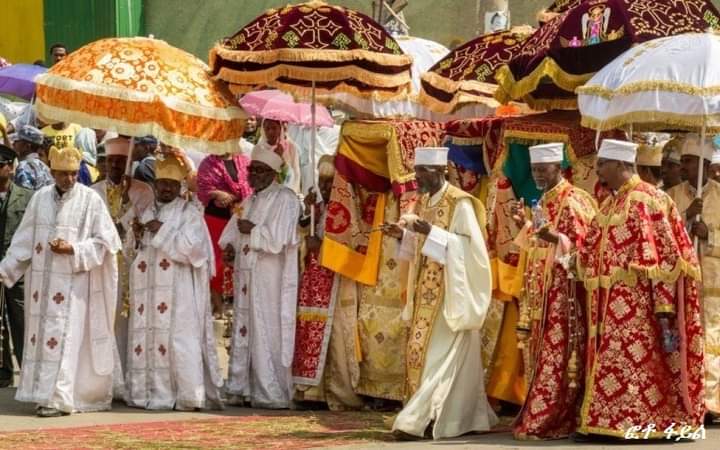The major religious content of the Ethiopian Epiphany is well preserved. But some most exhilarating cultural traditions, including traditional wearing and establishing serious relationships using a very traditional method, of Timket are either disappearing or eroding. We are going to explain these and the way forward.
Ethiopians Celebrate the UNESCO-inscribed Timket (Epiphany) festival colorfully since ancient times every year. The religious aspect of the Ethiopian Epiphany has been mainly preserved by the Ethiopian Orthodox Church.
Indeed, the colorful celebration of Epiphany in Ethiopia is thrilling to partake in due to its religious, cultural, and traditional fashion show and matchmaking opportunities.
However, the cultural aspect of the Epiphany ceremony is eroding and needs preservation in a modernized way. In this case, our organization is doing its best to preserve the magnificent culture of Ethiopia in a modernized and sustainable way. We supply cultural products and invest back to the preservation of cultural traditions. We are also strengthening partnerships with like-minded partners to achieve our vision.
The religious aspect of Timket
The word Timket is derived from the ancient Ethiopian language Ge’ez. In Ge’ez Timket is called Aster’eyo. Timket (Epiphany) is a colorful festival celebrated all over Ethiopia to commemorate the baptism of Jesus Christ by John the Baptist in the River Jordan. The commemoration starts on the eve of the main festival on 18 January. The eve is known as Ketera, which means blocking the flow of water for the blessing of the celebrants. On Ketera, people escort their parish church tabot (replicas of the Ark of the Covenant) to a pool, river, or artificial reservoir transported by a priest of the parish and accompanied by a great ceremony. The people spend the night attending night-long prayers and hymn services, including the Eucharistic Liturgy.
Hundreds of thousands participate in the actual festival on the following day – 19 January. The celebration starts early in the morning with pre-sunrise rituals. These are followed by the sprinkling of the blessed water on the congregation, as well as other ceremonies. In the late morning of that date, each tabot begins its procession back to its respective church, involving an even more colorful ceremony with various traditional and religious songs. The viability of the element is ensured through its continued practice, with Orthodox clergies playing a pivotal role: they sing the praises dedicated to the rituals and hymns, carry the Ark, and preach relevant texts.
The Intangible Cultural Aspect of the Timket Ceremony needs Preservation
The intangible cultural traditions of Timket including wearing traditional attires, songs, and performances as well as the matchmaking are inherited from past generations, being eroded at present, and not being maintained and bestowed for the benefit of future generations.
Cultural heritage includes tangible culture and intangible cultural traditions or living expressions inherited from our ancestors and passed on to our descendants, such as oral traditions, performing arts, social practices, rituals, festive events, knowledge, and practices concerning nature and the universe or the knowledge and skills to produce traditional crafts intangible culture and natural heritage.
Preserving cultural heritage requires an active effort on our part in order to safeguard it.
The cultural heritage of a nation has a very high value and is unique. It is an identity that can be promoted and introduced to the world. Cultural heritage affirms our identity as a people because it creates a comprehensive framework for the preservation of cultural heritage.
Along the religious ceremony from the Ketera (eve) to the actual Timket (Epiphany) celebration day on the 19th of January every year, most women and men, boys and girls wear attractive traditional attire widely known as Habesha Libs (the cloth or dress of the Habeas). Note that Habesha traditionally includes people in Ethiopia and Eritrea.
The cultural observations, including songs and dances, during the celebration particularly attract attendants’ non-believers of the Ethiopian Orthodox Church and even followers along the religious aspect. Tourists are especially attracted by the bright traditional dresses and clothes.
Timket is a religious holiday that is celebrated mainly by the followers of the Ethiopian Orthodox and Catholic Churches, but non-believers of the Ethiopian Orthodox Church also attend the festival. The festival is an indication of compassion, love, togetherness, and unity among societies that have different cultural and religious backgrounds.

Disappearing Matchmaking opportunities and underrated traditional fashion shows during Timket celebrations
During Timket (Epiphany) there is a steadily implied motive and desire to show homemade fashion and make intimate friendships. There was an interesting matchmaking way during the Epiphany celebration in Ethiopia until recent decades where men throw lemons at a crowd of women amid the Epiphany celebration to randomly pick a girl for a serious relationship. To make her their wife in short! It looks weird, but it isn’t. That was the most fascinating match-making method even after those dating apps came into existence. We have heard spouses sharing their experience of making family this way on media outlets. The lemon is considered like a pickup line here to put it into modern perspective. Many men made girlfriends, wives, and established families this way. Imagine a family married this way. From the female side, following the latest homegrown fashion and tradition could help attract the seemingly random throw of lemon to bias her.
Having said all this, it is crucial to invest and work on cultural preservation in a sustainable way.
Contact us
+1 (657) 262-9648
(971) 524265338
ashenda.org@gmail.com
Find us
Dallas, Texas
Dubai, United Arab Emirates
Copyright © 2023 Ashenda | All Rights Reserved
